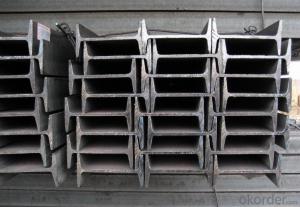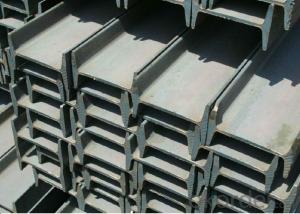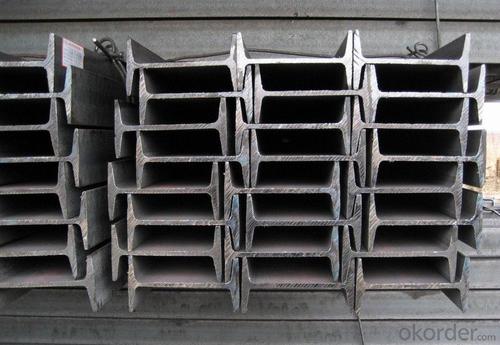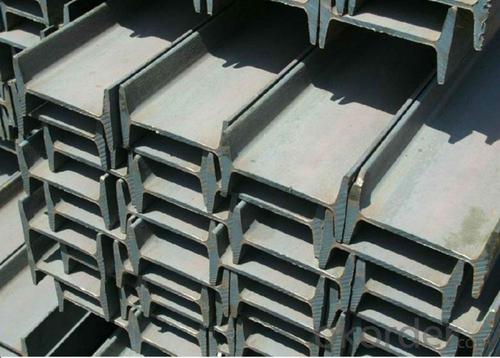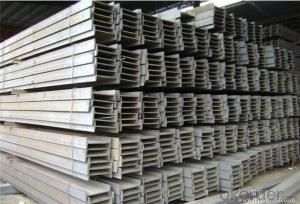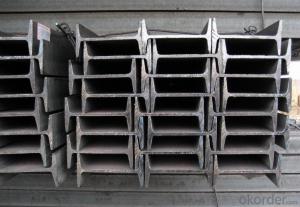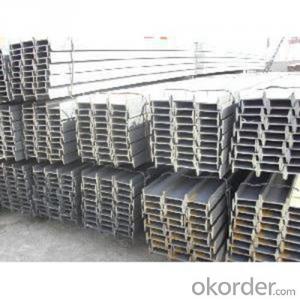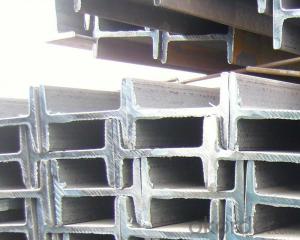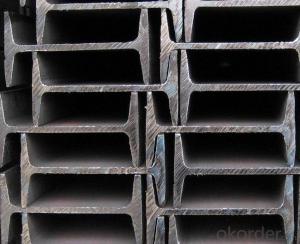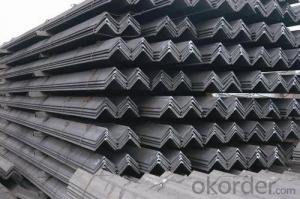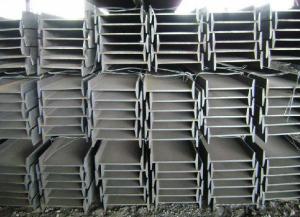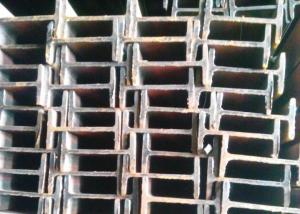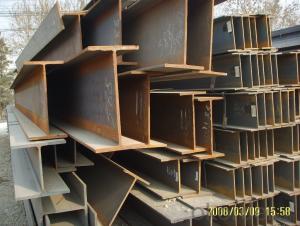European Standard IPE/IPEAA in Material Grade GB-Q235
- Loading Port:
- Tianjin
- Payment Terms:
- TT OR LC
- Min Order Qty:
- 25 m.t
- Supply Capability:
- 10000 m.t/month
OKorder Service Pledge
OKorder Financial Service
You Might Also Like
Product Description:
OKorder is offering high quality Hot Rolled Steel I-Beams at great prices with worldwide shipping. Our supplier is a world-class manufacturer of steel, with our products utilized the world over. OKorder annually supplies products to European, North American and Asian markets. We provide quotations within 24 hours of receiving an inquiry and guarantee competitive prices.
Product Applications:
1. Supporting members, most commonly in the house raising industry to strengthen timber bears under houses. Transmission line towers, etc
2. Prefabricated structure
3. Medium scale bridges
4. It is widely used in various building structures and engineering structures such as roof beams, bridges, transmission towers, hoisting machinery and transport machinery, ships, industrial furnaces, reaction tower, container frame and warehouse etc.
Product Advantages:
OKorder's Steel I-Beams are durable, strong, and resist corrosion.
Main Product Features:
· Premium quality
· Prompt delivery & seaworthy packing (30 days after receiving deposit)
· Corrosion resistance
· Can be recycled and reused
· Mill test certification
· Professional Service
· Competitive pricing
Product Specifications:
1. Invoicing on theoretical weight or actual weight as customer request
2. Standard: EN10025, GB Standard, ASTM
3. Grade: Q235B, Q345B, SS400, ASTM A36, S235JR, S275JR
4. Length: 5.8M, 6M, 9M, 12M as following table
5. Sizes: 80mm-270mm
Dimensions(mm) | |||||
h | b | s | t | Mass Kg/m | |
IPE80 | 80 | 46 | 3.80 | 5.20 | 6.00 |
IPE100 | 100 | 55 | 4.10 | 5.70 | 8.10 |
IPE120 | 120 | 64 | 4.80 | 6.30 | 10.40 |
IPE140 | 140 | 73 | 4.70 | 6.90 | 12.90 |
IPE160 | 160 | 82 | 5.00 | 7.40 | 15.80 |
IPE180 | 180 | 91 | 5.30 | 8.00 | 18.80 |
IPE200 | 200 | 100 | 5.60 | 8.50 | 22.40 |
IPE220 | 220 | 110 | 5.90 | 9.20 | 26.20 |
IPE240 | 240 | 120 | 6.20 | 9.80 | 30.70 |
IPE270 | 270 | 135 | 6.60 | 10.20 | 36.10 |
FAQ:
Q1: Why buy Materials & Equipment from OKorder.com?
A1: All products offered byOKorder.com are carefully selected from China's most reliable manufacturing enterprises. Through its ISO certifications, OKorder.com adheres to the highest standards and a commitment to supply chain safety and customer satisfaction.
Q2: How do we guarantee the quality of our products?
A2: We have established an advanced quality management system which conducts strict quality tests at every step, from raw materials to the final product. At the same time, we provide extensive follow-up service assurances as required.
Q3: The products are invoicing on theoritical weight or on actual weight?
A3: We can do it in both manners, according to the customers' request.
Images:
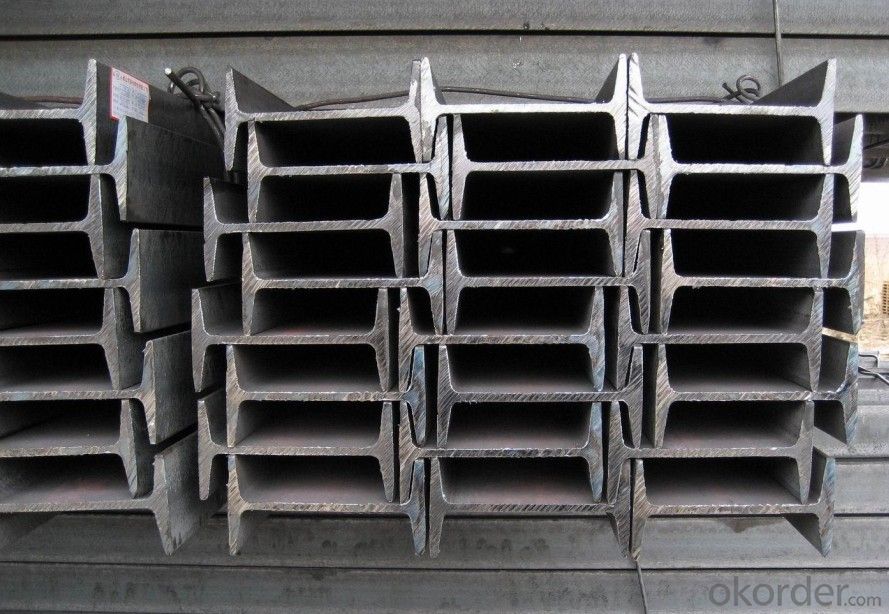
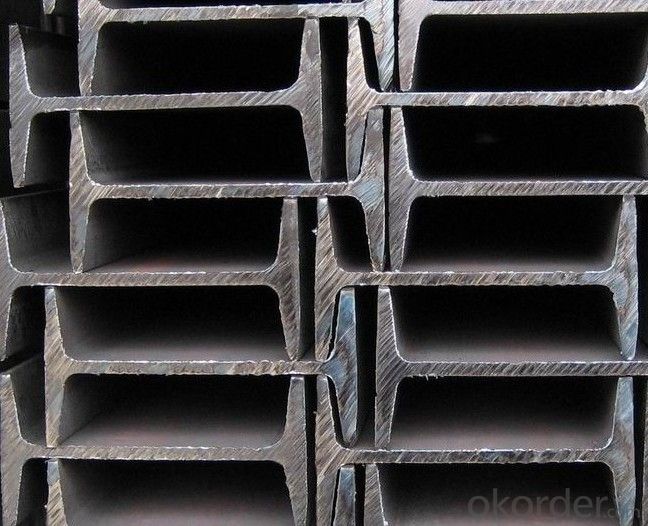
- Q: How do steel I-beams handle extreme temperatures?
- Steel I-beams are renowned for their exceptional strength and durability, making them a favored option for structural support in various applications. Steel I-beams typically perform admirably in extreme temperatures due to their unique properties. Steel possesses a high melting point, typically around 1370 degrees Celsius (2500 degrees Fahrenheit). Consequently, steel I-beams can generally endure extreme temperatures without significant structural damage. However, it is important to acknowledge that steel expands and contracts with temperature fluctuations, which can impact its overall performance. During high-temperature circumstances, such as fires, steel I-beams may experience a decrease in strength due to thermal expansion. As the temperature rises, the steel expands, potentially leading to distortions and buckling. Nevertheless, steel's inherent strength enables it to maintain its load-bearing capacity even when subjected to heat. Conversely, in extremely cold temperatures, steel tends to become more brittle and prone to fracturing. This is a result of reduced ductility, which refers to a material's ability to deform without breaking. Under these conditions, steel I-beams may become more susceptible to cracking, especially if exposed to sudden impacts or excessive loads. To mitigate the effects of extreme temperatures, engineers and designers frequently employ various techniques. These can include incorporating fire protection measures, such as fire-resistant coatings or insulation, to delay the onset of thermal expansion and preserve the structural integrity of steel I-beams during fires. Additionally, careful consideration is given to the selection of materials and the design of the I-beams to ensure they can withstand anticipated temperature variations. In conclusion, steel I-beams generally excel in handling extreme temperatures. They possess a high melting point and maintain their load-bearing capacity even when exposed to high temperatures. However, precautions must be taken in extremely cold temperatures to prevent potential brittleness and cracking. Proper design, material selection, and implementation of fire protection measures can help ensure the performance and longevity of steel I-beams in environments with extreme temperatures.
- Q: Can steel I-beams be used in hospitals?
- Yes, steel I-beams can be used in hospitals. Steel I-beams are commonly used in construction due to their strength, durability, and load-bearing capabilities. In hospitals, they can be used to provide structural support for the building, especially in areas that require large open spaces and heavy equipment, such as operating rooms or diagnostic labs. Additionally, steel I-beams can be used to create sturdy and secure frames for doors, windows, and partitions.
- Q: Can steel I-beams be used in the construction of residential bridges?
- Yes, steel I-beams can be used in the construction of residential bridges. They provide structural support and have high load-bearing capacity, making them suitable for small to medium-sized bridges commonly found in residential areas.
- Q: How do steel I-beams perform in areas with high salinity or corrosive environments?
- Areas with high salinity or corrosive environments can pose challenges for steel I-beams, but proper protection and maintenance can help them perform well. Coastal regions and industrial areas, which are known for their high salinity and corrosive elements, can accelerate the corrosion process and potentially compromise the structural integrity of steel. To counteract the effects of high salinity and corrosion, steel I-beams are often coated with protective materials like galvanized coatings, epoxy coatings, or specialized paint systems. These coatings act as a barrier, preventing direct contact between the steel and the corrosive elements. Regular inspections and maintenance are also crucial to promptly identify and address any signs of corrosion. Nevertheless, it should be noted that even with protective coatings, steel I-beams in high salinity or corrosive environments may have a shorter lifespan compared to those in less corrosive environments. The severity of the environment, the quality of the coatings, and the maintenance practices all play significant roles in determining the performance and longevity of steel I-beams in such conditions. In extremely harsh environments, alternative materials such as stainless steel or fiberglass-reinforced polymers (FRP) may be considered, as they inherently possess greater resistance to corrosion. These materials offer extended durability and are commonly used in marine structures or other applications where corrosive conditions are prevalent. All in all, steel I-beams can still be a feasible choice in areas with high salinity or corrosive environments, as long as appropriate protective measures are taken and regular maintenance is carried out. Seeking guidance from structural engineers or corrosion specialists can help determine the most suitable approach to ensure the long-term performance and safety of steel I-beams in such conditions.
- Q: Are there any special considerations when designing with steel I-beams for long-span structures?
- Yes, there are several special considerations when designing with steel I-beams for long-span structures. Firstly, the weight and load-bearing capacity of the I-beams must be carefully calculated to ensure they can support the anticipated loads. Long-span structures often experience higher loads and stresses due to their larger spans, so it is crucial to select I-beams with sufficient strength and stiffness. Secondly, the deflection of the I-beams must be carefully controlled to prevent excessive sagging or bending. This can be achieved by using thicker and stronger beams, or by incorporating additional support elements such as trusses or cross beams. Thirdly, the thermal expansion and contraction of steel must be taken into account. Long-span structures are more susceptible to temperature changes, which can cause the steel beams to expand or contract. Proper allowances for thermal movement must be made to prevent structural issues or damage. Additionally, the connections between the I-beams and other structural elements must be carefully designed to ensure proper load transfer and structural integrity. Special attention should be given to the connection details to ensure they can accommodate the expected loads and account for any potential movement or deflection of the beams. Finally, the overall structural stability and resistance to lateral forces, such as wind or seismic loads, must be carefully considered. Long-span structures are more vulnerable to these forces, and proper bracing and structural reinforcement must be incorporated to ensure the overall stability and safety of the design. In summary, designing with steel I-beams for long-span structures requires careful consideration of weight, load-bearing capacity, deflection, thermal expansion, connections, and overall stability. By addressing these special considerations, engineers can create safe and efficient designs for long-span structures using steel I-beams.
- Q: What are the different types of steel I-beam connections for beam-to-beam joints?
- There exist various options for connecting steel I-beams at beam-to-beam joints. Some of the most frequently used types comprise: 1. Employing welded connections: This approach involves fusing the two beams together at the joint. It yields a sturdy and inflexible connection, yet demands skilled labor and can be time-consuming. 2. Utilizing bolted connections: This method necessitates the use of bolts and nuts to secure the beams at the joint. It is simpler to assemble and disassemble in comparison to welded connections, though it may not offer as much rigidity. 3. Employing riveted connections: This traditional technique entails using rivets to connect the beams. While it is less commonly employed nowadays, it furnishes a robust and long-lasting connection. 4. Implementing moment connections: These connections are specifically designed to transfer bending moments between the beams. They are typically employed in situations where the beams encounter heavy loads and require additional support. 5. Utilizing shear connections: These connections are intended to transfer shear forces between the beams. They are commonly employed in situations where the beams are exposed to lateral loads or wind forces. 6. Opting for slotted connections: This type of connection involves incorporating slots in the beams to allow for adjustability and flexibility. It is often employed when precise alignment or adjustment is required. Considering the specific project requirements and consulting with a structural engineer is crucial in order to determine the most suitable type of steel I-beam connection for beam-to-beam joints. Factors such as load capacity, structural design, and ease of installation should be taken into account when selecting the appropriate connection method.
- Q: What are the considerations for steel I-beam design in corrosive environments?
- When designing steel I-beams for corrosive environments, there are several important considerations to take into account. These considerations are crucial in order to ensure the longevity and safety of the structure. 1. Material Selection: Choosing the right type of steel is critical. Stainless steel, particularly grades such as 316 or duplex stainless steel, is often preferred due to its high corrosion resistance. These alloys contain additional elements like chromium and molybdenum that offer superior protection against corrosion compared to standard carbon steel. 2. Coatings and Surface Treatments: Applying appropriate coatings or surface treatments can further enhance the corrosion resistance of steel I-beams. Common options include hot-dip galvanizing, which involves immersing the steel in molten zinc, or epoxy coatings. These protective layers act as a barrier between the steel surface and corrosive agents. 3. Environmental Factors: Understanding the specific corrosive environment is crucial for steel I-beam design. Factors such as temperature, humidity, chemical exposure, and the presence of pollutants should be considered. For example, marine environments, where saltwater is present, can be particularly corrosive and require additional protection measures. 4. Maintenance and Inspection: Regular maintenance and inspection are essential to identify and address any signs of corrosion in steel I-beams. This includes monitoring the condition of coatings, promptly repairing any damaged areas, and ensuring proper drainage to prevent water accumulation. 5. Structural Design: The structural design of steel I-beams should consider the potential effects of corrosion. This may involve increasing the section dimensions to compensate for any anticipated loss of material due to corrosion. Additionally, designs should incorporate adequate ventilation to minimize moisture accumulation and promote drying. 6. Compatibility with Adjacent Materials: When designing steel I-beams for corrosive environments, it is important to consider the compatibility of the steel with other materials used in the structure. For example, the use of dissimilar metals in contact with steel can lead to galvanic corrosion. Proper insulation or the use of compatible materials can help prevent this type of corrosion. In conclusion, designing steel I-beams for corrosive environments requires careful consideration of material selection, coatings or surface treatments, environmental factors, maintenance, inspection, structural design, and compatibility with adjacent materials. By addressing these considerations, engineers can ensure the durability and integrity of steel I-beams in corrosive environments.
- Q: Can steel I-beams be used for shopping malls?
- Yes, steel I-beams can be used for shopping malls. In fact, steel is a common material used in the construction of large commercial buildings like shopping malls due to its strength, durability, and versatility. Steel I-beams provide excellent support for the structural framework of the building, allowing for wide open spaces and flexible floor plans. They can withstand heavy loads and provide stability, making them ideal for supporting the weight of multiple floors, roofs, and large spans. Additionally, steel is fire-resistant, which enhances the safety of the building. Overall, steel I-beams are a reliable and cost-effective choice for constructing shopping malls.
- Q: Can steel I-beams be used in renovation or retrofitting projects?
- Yes, steel I-beams can definitely be used in renovation or retrofitting projects. Steel I-beams are commonly used in construction due to their strength and durability. They can be used to provide additional support to existing structures, such as reinforcing load-bearing walls or floors. Steel I-beams are also often used to create open floor plans in renovations by removing load-bearing walls and replacing them with the beams to support the weight above. Additionally, steel I-beams can be used in retrofitting projects to strengthen and stabilize older buildings that may not have been originally designed to withstand certain loads or forces. Overall, steel I-beams are a versatile and effective solution for various renovation or retrofitting projects.
- Q: What are the different types of coatings available for Steel I-Beams?
- There are several types of coatings available for steel I-beams, including paint coatings, galvanized coatings, and epoxy coatings. Paint coatings provide a protective layer against corrosion and can be applied in various colors. Galvanized coatings involve a process where a layer of zinc is applied to the steel, providing excellent corrosion resistance. Epoxy coatings are a durable option that offer chemical resistance, abrasion resistance, and provide a smooth finish to the I-beams.
Send your message to us
European Standard IPE/IPEAA in Material Grade GB-Q235
- Loading Port:
- Tianjin
- Payment Terms:
- TT OR LC
- Min Order Qty:
- 25 m.t
- Supply Capability:
- 10000 m.t/month
OKorder Service Pledge
OKorder Financial Service
Similar products
Hot products
Hot Searches
Related keywords
